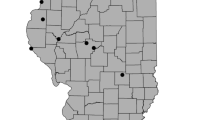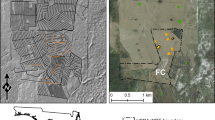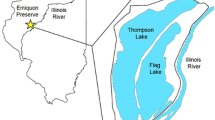Abstract
Projects of the scope of the restoration of the Florida Everglades require substantial information regarding ecological mechanisms, and these are often poorly understood. We provide critical base knowledge for Everglades restoration by characterizing the existing vegetation communities of an Everglades remnant, describing how present and historic hydrology affect wetland vegetation community composition, and documenting change from communities described in previous studies. Vegetation biomass samples were collected along transects across Water Conservation Area 3A South (3AS). Ten community types were present between November 2002 and 2005. Separate analyses for key a priori groups (slough, wet prairie, and sawgrass) provided detailed conclusions about effects of historic hydrology on the vegetation of 3AS. Communities were affected by hydrologic variables up to four years previous to the sample. We identified wet prairie/slough species such as Eleocharis spp. and Nymphaea odorata as short-term sentinel species of community change. Sawgrass and N. odorata should be monitored for long-term change. Comparisons to preceding studies indicated that many of the communities of previous times, when conditions were drier, no longer exist in our study area and have been replaced by deeper water community types.
Similar content being viewed by others
Literature Cited
Armentano, T. V., J. P. Sah, M. S. Ross, D. T. Jones, H. C. Cooley, and C. S. Smith. 2006. Rapid responses of vegetation to hydrological changes in Taylor Slough, Everglades National Park, Florida, USA. Hydrobiologia 569: 293–309.
Bazante, J., G. Jacobi, H. M. Solo-Gabriele, D. Reed, S. Mitchell-Bruker, D. L. Childers, L. Leonard, and M. Ross. 2006. Hydrologic measurements and implications for tree island formation within Everglades National Park. Journal of Hydrology 329: 606–19.
Busch, D. E., W. F. Loftus, and O. L. BassJr. 1998. Long-term hydrologic effects on marsh plant community structure in the southern Everglades. Wetlands 18: 230–41.
Childers, D. L., R. F. Doren, G. B. Noe, M. Rugge, and L. J. Scinto. 2003. Decadal change in vegetation and soil phosphorus patterns across the Everglades landscape. Journal of Environ-mental Quality 32: 344–62.
Childers, D. L., D. Iwaniec, D. Rondeau, G. Rubio, E. Verdon, and C. J. Madden. 2006. Responses of sawgrass and spikerush to variation in hydrologic drivers and salinity in southern Everglades marshes. Hydrobiologia 569: 273–92.
Conrads, P. A., E. Roehls, R. Daamen, and W. M. Kitchens. 2006. Using artificial neural network models to integrate hydrologic and ecological studies of the snail kite in the Everglades, USA. p. 1–8. In Proceedings of the 7th International Conference on Hydroinformatics, Nice, France.
Craft, C. B., J. Vymazal, and C. J. Richardson. 1995. Response of Everglades plant communities to nitrogen and phosphorous additions. Wetlands 15: 259–71.
David, P. G. 1996. Changes in plant communities relative to hydrologic conditions in the Florida Everglades. Wetlands 16: 15–23.
Davis, J. H., Jr. 1943. The natural features of southern Florida, especially the vegetation, and the Everglades. Florida Geological Survey Bulletin, No. 25.
Davis, S. M. 1997. Phosphorus inputs and vegetation sensitivity in the Everglades. p. 537–78. In S. M. Davis and J. C. Ogden (eds.) Everglades: The Ecosystem and Its Restoration. CRC Press, Boca Raton, FL, USA.
Davis, S. M., L. H. Gunderson, W. A. Park, J. R. Richardson, and J. E. Mattson. 1997. Landscape dimension, composition, and function in a changing Everglades ecosystem. p. 419–44. In S. M. Davis and J. C. Ogden (eds.) Everglades: The Ecosystem and Its Restoration. CRC Press, Boca Raton, FL, USA.
Daoust, R. J. and D. L. Childers. 1999. Controls on emergent macrophyte composition, abundance, and productivity in fresh-water Everglades wetland communities. Wetlands 19: 262–75.
DeSteven, D. and M. M. Toner. 2004. Vegetation of upper coastal plain wetlands: environmental templates and wetland dynamics within a landscape framework. Wetlands 24: 23–42.
Dufrêne, M. and P. Legendre. 1997. Species assemblages and indicator species: the need for a flexible asymmetrical approach. Ecological Monographs 67: 345–66.
Edwards, A. L., D. W. Lee, and J. H. Richards. 2003. Responses to a fluctuating environment: effects of water depth on growth and biomass allocation in Eleocharis cellulosa Torr. (Cyperaceae). Canadian Journal of Botany 81: 964–75.
Gunderson, L. H. 1989. Historical hydropatterns in wetland communities of Everglades National Park. p. 1099–11. In R. R. Sharitz and J. W. Gibbons (eds.) Freshwater Wetlands and Wildlife Symposium Series No. 61. USDOE Office of Scientific and Technical Information, Oak Ridge, TN, USA.
Gunderson, L. H. 1997. Vegetation of the Everglades: determinants of community composition. p. 323–40. In S. M. Davis and J. C. Ogden (eds.) Everglades: The Ecosystem and Its Restoration. CRC Press, Boca Raton, FL, USA.
Herndon, A., L. H. Gunderson, and J. Stenberg. 1991. Sawgrass (Cladium jamaicense) survival in a regime of fire and flooding. Wetlands 11: 17–27.
Kitchens, W. K., R. E. Bennetts, and D. L. DeAngelis. 2002. Linkages between the snail kite population and wetland dynamics in a highly fragmented south Florida hydroscape. p. 183–204. In J. W. Porter and K. G. Porter (eds.) The Everglades, Florida Bay, and Coral Reefs of the Florida Keys: An Ecosystem Sourcebook. CRC Press, Boca Raton, FL, USA.
Kruskal, J. B. 1964. Nonmetric multidimensional scaling: a numerical method. Psychometrika 29: 1–27.
Laitinen, J., S. Rehell, and J. Oksanen. 2008. Community and species responses to water level fluctuations with reference to soil layers in different habitats of mid-boreal mire complexes. Plant Ecology 194: 17–36.
Light, S. S. and J. W. Dineen. 1997. Water control in the Everglades: a historical perspective. p. 47–84. In S. M. Davis and J. C. Ogden (eds.) Everglades: The Ecosystem and Its Restoration. CRC Press, Boca Raton, FL, USA.
Loveless, C. M. 1959. A study of the vegetation in the Florida Everglades. Ecology 40: 1–9.
Macek, P., E. Rejmánková, and K. Houdková. 2006. The effect of long-term submergence on functional properties of Eleocharis cellulosa Torr. Aquatic Botany 84: 251–58.
MacPherson, B. F. and R. Halley. 1996. The South Florida environment—a region under stress. U.S. Geological Survey Circular 1134. U.S. Geological Survey, Branch of Information Services, Denver, CO, USA.
Mather, P. M. 1976. Computational methods of multivariate analysis in physical geography. John Wiley and Sons, London, UK.
McCune, B. and J. B. Grace. 2002. Analysis of Ecological Communities. MjM Software, Glenden Beach, OR, USA.
McCune, B. and M. J. Mefford. 1999. PC-ORD: Multivariate analysis of ecological data v. 4.41. MjM Software Design, Medford, OR.
Mielke, JrP. W. and K. L. Berry. 2001. Permutation Methods: A Distance Function Approach. Springer Series in Statistics, Berlin, Germany.
Science Sub-Group. 1994. South Florida ecosystem restoration: scientific information needs. Draft. Management and Coordination Working Group, Interagency Task Force on the South Florida Ecosystem.
Seabloom, E. W., K. A. Moloney, and A. G. van der Valk. 2001. Constraints on the establishment of plants along a fluctuating water-depth gradient. Ecology 82: 2216–32.
Snyder, J. M. and J. H. Richards. 2005. Floral phenology and compatibility of sawgrass, Cladium jamaicense (Cyperaceae). American Journal of Botany 92: 736–43.
Wierserma, J. H. 1998. Reproductive biology of Nymphaea (Nymphaeaceae). Annals of the Missouri Botanical Garden 75: 795–804.
Wood, J. M. and G. W. Tanner. 1990. Graminoid community composition and structure within four Everglades management areas. Wetlands 10: 127–49.
Wu, Y., F. H. Sklar, and K. Rutchey. 1997. Analysis and simulations of fragmentation patterns in the Everglades. Ecological Applications 7: 268–76.
Zaremba, R. E. and E. E. Lamont. 1993. The status of the coastal plain pondshore community in New York. Bulletin of the Torrey Botanical Club 120: 180–87.
Zedler, J. B. 2000. Progress in wetland restoration ecology. Trends in Ecology and Evolution 15: 402–07.
Author information
Authors and Affiliations
Corresponding author
Rights and permissions
About this article
Cite this article
Zweig, C.L., Kitchens, W.M. Effects of landscape gradients on wetland vegetation communities: Information for large-scale restoration. Wetlands 28, 1086–1096 (2008). https://doi.org/10.1672/08-96.1
Received:
Accepted:
Issue Date:
DOI: https://doi.org/10.1672/08-96.1




